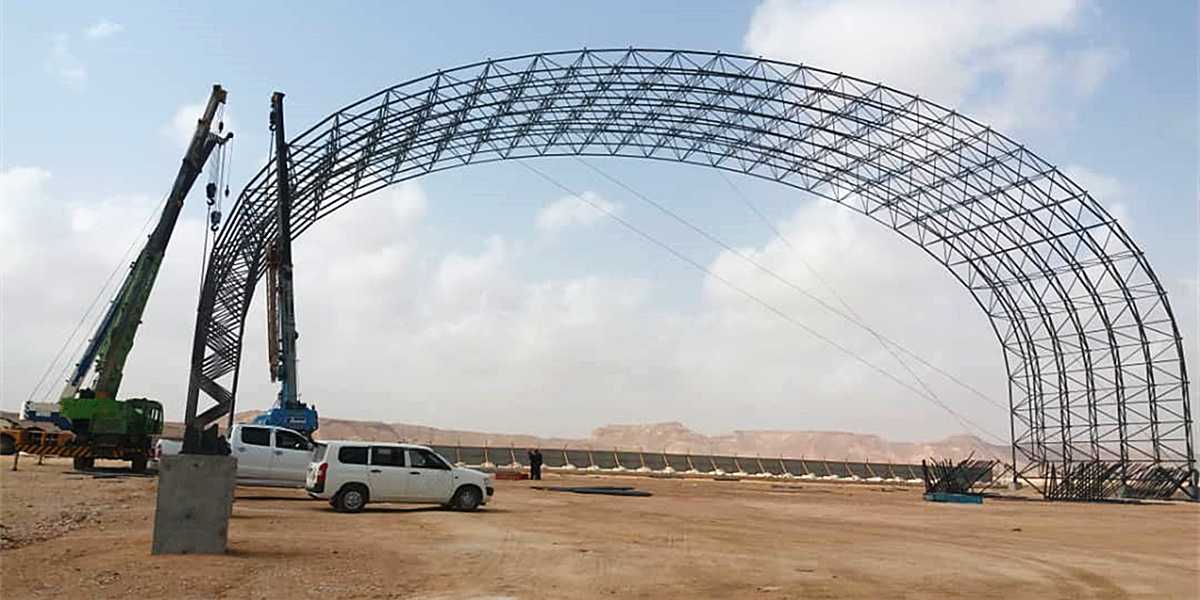The structural grid is a crucial element in architectural design and construction that organizes and aligns building components, creating a framework for distributing loads and providing stability to structures. Structural grids serve as an essential design tool for architects and engineers, aiding in space planning, ensuring precision in layout, and offering flexibility for future expansions. The grid framework is typically composed of intersecting horizontal and vertical lines or columns and beams that determine the spacing, alignment, and structural support for the entire building.
This passage will cover the top uses of structural grids from reputable manufacturer like Aicrane in construction, including facilitating load distribution, enhancing modular construction, aiding in building expansions, simplifying project coordination, and improving overall project efficiency.

Load Distribution and Structural Stability
One of the primary uses of a structural grid is to ensure even load distribution across a building’s foundation and structural framework. Each intersection in the grid generally represents the location of a column, beam, or other load-bearing component that contributes to the stability and strength of the building.
Even Load Distribution: By aligning columns and beams according to a planned grid, the structural load is evenly distributed to the foundation. This distribution minimizes the risk of concentrated stress points, which can lead to structural failures.
Enhanced Structural Stability: Grids ensure that each section of the building carries its designated load, reducing excessive stress on any one area. This uniform load distribution is particularly crucial in earthquake-prone areas, as it provides additional resilience against lateral forces.
In high-rise buildings or complex structures, load distribution across a structural grid supports the integrity of the building under various stresses, from weight loads to environmental forces like wind and seismic activity.
Simplifying Modular Construction
The structural grid is integral to modular construction, where buildings are designed with prefabricated modules that can be easily assembled on-site. Grids facilitate a high degree of precision, ensuring that modular components fit seamlessly within the designated framework.
Efficient Assembly: Structural grids allow prefabricated elements to align precisely, making the assembly process faster and more accurate. This alignment reduces construction errors and ensures that components fit perfectly, which is crucial for prefabricated or modular construction.
Reduced Waste and Increased Sustainability: A well-designed grid allows for the efficient use of materials by minimizing cutting and reshaping of components. This material efficiency reduces waste, contributes to sustainability, and often lowers the overall cost of the project.
Flexibility and Adaptability: Structural grids provide flexibility in modular construction, allowing designers to add or remove sections based on project requirements. This adaptability is particularly valuable for projects where changes may be made to the original design, such as expanding a building or repurposing sections for different uses.
The use of grids in modular construction enhances productivity and sustainability, making it a popular choice in contemporary architecture and construction practices.
Facilitating Building Expansions and Adaptability
Structural grids are also essential for buildings with planned expansions or where future adaptability is a priority. The grid provides a consistent pattern that enables easy additions or modifications to the existing structure without compromising stability.
Easy Addition of New Sections: Since the grid establishes uniform spacing for columns and beams, adding new structural elements is straightforward. This alignment ensures that new sections blend seamlessly with the existing building, maintaining aesthetic consistency and structural integrity.
Adaptable Design for Multi-Use Spaces: Many commercial and industrial buildings require adaptable spaces for evolving business needs. A structural grid allows the building’s layout to be adjusted by moving or adding partitions, creating new rooms, or converting spaces without extensive structural changes.
Cost-Effective Future Modifications: When expansion or redesign is built into the structural plan, the need for extensive demolition or reinforcement is minimized. This saves time, money, and resources, making it easier and less expensive to reconfigure or expand as the need arises.
With a structural grid in place, the lifecycle of a building can be extended, and adaptability is enhanced, providing long-term value and supporting future business growth.
Supporting Spatial Organization and Design Precision
A structural grid serves as a blueprint for spatial organization within the building, guiding the placement of walls, doors, windows, and other elements. This precision helps architects and interior designers optimize space for both aesthetics and functionality.
Space Planning and Layout Optimization: By dividing spaces into regular, easily measurable units, grids make it easy to plan room layouts, optimize circulation, and ensure that all spaces are proportionate. This is particularly beneficial in large commercial buildings where efficient space usage is essential.
Improved Precision and Symmetry: A structural grid provides a consistent pattern, enabling symmetry and order within the design. For example, window placements, column locations, and floor spacing can all follow the grid pattern, resulting in a cohesive and harmonious architectural design.
Enhanced Functionality: With a structured layout, functional spaces like hallways, staircases, and elevators can be positioned more effectively, contributing to smoother building flow. The grid makes it easier to achieve ergonomic designs that improve usability and comfort for occupants.
Structural grids thus provide a foundation for meticulous spatial planning, ensuring that both functionality and aesthetic appeal are well-integrated into the design.
Simplifying Coordination Among Project Teams
Structural grids improve collaboration and coordination among the different teams involved in construction, from architects and engineers to contractors and on-site workers. A grid provides a common reference, enabling all parties to understand the layout and contribute to a streamlined workflow.
Clear Communication and Reduced Misalignment: A structural grid acts as a universal layout guide, reducing the likelihood of misunderstandings or misalignment between different project stakeholders. Engineers, for example, can clearly communicate structural specifications to contractors, making the construction process more efficient.
Efficient Installation of Building Systems: A grid simplifies the placement of electrical, plumbing, and HVAC systems, ensuring that these installations align with the structural framework and architectural design. This alignment also makes maintenance easier, as systems are installed in predictable locations.
Project Time Savings: By using a structural grid as a reference, teams can work more efficiently and minimize delays. Missteps in measurements or placements are reduced, saving time in construction and helping the project stay on schedule.
The grid-based system not only supports clear communication and project organization but also ensures that the final construction adheres to the original design intent.
Increasing Project Efficiency and Cost Savings
A structural grid enables significant cost savings by minimizing design complexity, reducing waste, and improving construction speed. This systematic approach reduces the risk of costly errors, rework, and delays.
Streamlined Construction Process: The grid provides a predictable framework, which simplifies construction sequencing and allows for efficient material procurement and labor allocation. By reducing complexity, construction tasks can be completed faster, reducing labor costs.
Reduced Rework and Wastage: By following a structured grid, there’s less chance of alignment errors, material waste, or costly rework. Components are ordered and prefabricated according to grid specifications, reducing the need for adjustments on-site.
Cost-Effective Building Maintenance: The uniformity provided by the structural grid simplifies maintenance tasks, as systems like electrical and plumbing are predictably organized. This uniformity enables quicker repairs and less disruption for occupants, further lowering maintenance costs over the building’s life.
Incorporating a structural grid in construction improves efficiency, reduces unnecessary expenditures, and helps keep projects within budget.
The structural grid is an invaluable tool in the construction industry, serving multiple roles from ensuring load stability to facilitating modular construction, expansions, and spatial organization. Grids enhance coordination among project teams, drive cost savings, and enable flexible future modifications. By creating a predictable and organized framework, structural grids enhance the overall functionality and longevity of buildings, making them an essential aspect of modern architectural and engineering practices. For projects that demand precision, adaptability, and efficient use of resources, the structural grid remains a foundational element that guides the design and construction processes from inception to completion.






